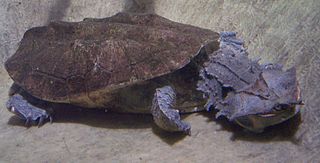
Chelidae is one of three living families of the turtle suborder Pleurodira, and are commonly called Austro-South American side-neck turtles. The family is distributed in Australia, New Guinea, parts of Indonesia, and throughout most of South America. It is a large family of turtles with a significant fossil history dating back to the Cretaceous. The family is entirely Gondwanan in origin, with no members found outside Gondwana, either in the present day or as a fossil.

Limaysaurus is a genus represented by a single species of rebbachisaurid sauropod dinosaurs, which lived during the mid-Cretaceous period, about 99.6 to 97 million years ago, in the Cenomanian, in what is now South America.

The Lohan Cura Formation is a geologic formation with outcrops in the Argentine provinces of Río Negro, Neuquén, and Mendoza. It is the second oldest Cretaceous terrestrial formation in the Neuquén Basin.

Genyodectes is a genus of ceratosaurian theropod dinosaur from the Lower Cretaceous (Aptian) of South America. The holotype material was collected from the Cerro Barcino Formation, Cañadón Grande, Departamento Paso de Indios in the Chubut Province of Argentina and consists of an incomplete snout, including the premaxillae, portions of both maxillas, the right and left dentary, many teeth, a fragment of the left splenial, and parts of the supradentaries. These elements are generally poorly preserved and some are in articulation. The premaxilla of Genyodectes possesses relatively large and protruding teeth, similar to those of Ceratosaurus. The specific name, serus, means "late". In 2016 it was estimated to be 6.25 meters in length and 790 kg in weight.

Patagosaurus is an extinct genus of eusauropod dinosaur from the Middle-Late Toarcian of Patagonia, Argentina. It was first found in deposits of the Cañadón Asfalto Formation, which date to around 179 to 177 million years ago. Although originally twelve specimens were assigned to the taxon, at least one of them may belong to a different genus. Patagosaurus probably lived alongside genera as Piatnitzkysaurus, Condorraptor and Volkheimeria.
The Cerro Barcino Formation is a geological formation in South America whose strata span the Early Cretaceous to the earliest Late Cretaceous. The top age for the formation has been estimated to be Cenomanian. Earlier estimates placed the formation until the Campanian.
Condorchelys was a genus of stem turtle from Early Jurassic Cañadon Asfalto Formation of Argentina. Condorchelys represents the oldest Jurassic-aged Turtle from South America, with only one species described, Condorchelys antiqua.
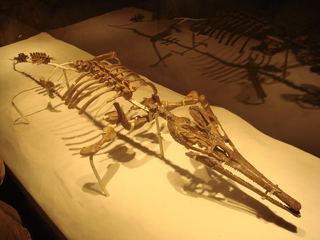
Tchoiria () is a genus of neochoristoderan reptile from the Early Cretaceous of Mongolia. The name Tchoiria comes from the city of Choir which is nearby to where the holotype was found. Tchoiria is thought to have a similar diet to another neochoristoderan reptile, Champsosaurus, due to morphology of the skull. It would hunt in freshwater environments, like the living gharials, where it would prey on many different types of fish and turtles.
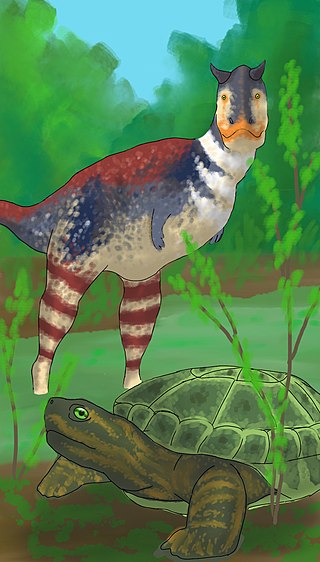
Patagoniaemys is an extinct genus of stem turtle which existed in central Patagonia, Chubut Province, Argentina during the late Cretaceous epoch. It is known from skull fragments and several postcranial elements including a nearly complete vertebral column recovered from the La Colonia Formation. It was first named by Juliana Sterli and Marcelo S. de la Fuente in 2011, and the type species is Patagoniaemys gasparinae.
Barcinosuchus is an extinct genus of carnivorous metasuchian from the early Cretaceous period. It is a peirosaurid which lived during the early Cretaceous period in what is now Chubut Province, Argentina. It is known from the holotype MPEF-PV 3095, which consists of skull, mandible, and postcranial remains. The specimen recovered from the lower part of the Cerro Castaño Member of the Cerro Barcino Formation. Barcinosuchus was named by Martín Leardi and Diego Pol in 2009 and the type species is Barcinosuchus gradilis.
Prochelidella is an extinct genus of Early to Late Cretaceous chelid turtles from the Bajo Barreal, Candeleros, Cerro Barcino and Portezuelo Formations of the Cañadón Asfalto, Golfo San Jorge and Neuquén Basins in Patagonia, Argentina. It includes the following species:
Paluxysuchus is an extinct genus of neosuchian crocodyliform known from the Early Cretaceous Twin Mountains Formation of north-central Texas. It contains a single species, Paluxysuchus newmani. Paluxysuchus is one of three crocodyliforms known from the Early Cretaceous of Texas, the others being Pachycheilosuchus and an unnamed species referred to as the "Glen Rose Form". Paluxysuchus has a long, flat skull that is probably transitional between the long and narrow skulls of many early neosuchians and the short and flat skulls of later neosuchians.
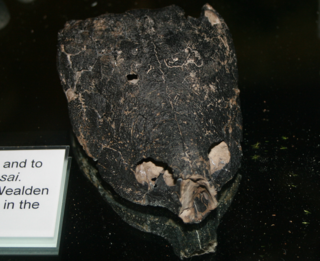
The Helochelydridae are an extinct family of stem-turtles known from fossils found in North America and Europe spanning the Early to Late Cretaceous.
Patagosuchus is an extinct genus of peirosaurid crocodyliform known from the early Late Cretaceous Portezuelo Formation of Neuquén Province, western central Argentina. It contains a single species, Patagosuchus anielensis. It is distinguished from other peirosaurids by its extremely heterodont dentition, which includes small serrated teeth at the front of the jaws with much larger, laterally compressed caniniform teeth behind them. Patagosuchus also has large spaces between its teeth called interalveolar spaces that are not found in any other peirosaurid.

Leyvachelys is an extinct genus of turtles in the family Sandownidae from the Early Cretaceous of the present-day Altiplano Cundiboyacense, Eastern Ranges, Colombian Andes. The genus is known only from its type species, Leyvachelys cipadi, described in 2015 by Colombian paleontologist Edwin Cadena. Fossils of Leyvachelys have been found in the fossiliferous Paja Formation, close to Villa de Leyva, Boyacá, after which the genus is named. The holotype specimen is the oldest and most complete sandownid turtle found to date.
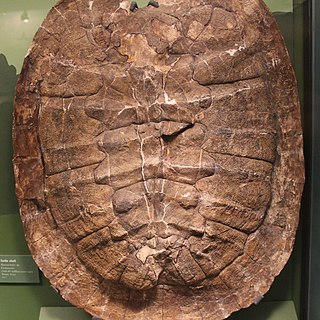
Naomichelys is an extinct genus of helochelydrid stem turtle known from the Cretaceous (Aptian-Campanian) of North America. It is the only member of the family known to be native to North America.
The Cañadón Asfalto Basin is an irregularly shaped sedimentary basin located in north-central Patagonia, Argentina. The basin stretches from and partly covers the North Patagonian Massif in the north, a high forming the boundary of the basin with the Neuquén Basin in the northwest, to the Cotricó High in the south, separating the basin from the Golfo San Jorge Basin. It is located in the southern part of Río Negro Province and northern part of Chubut Province. The eastern boundary of the basin is the North Patagonian Massif separating it from the offshore Valdés Basin and it is bound in the west by the Patagonian Andes, separating it from the small Ñirihuau Basin.
Kaikaifilusaurus is an extinct genus of rhynchocephalians in the family Sphenodontidae from the Late Cretaceous of South America. Fossils of the genus were found in Cenomanian sediments of the Candeleros Formation and Turonian layers of the Huincul Formation, both of the Neuquén Basin and the Albian strata of the Cerro Barcino Formation in the Cañadón Asfalto Basin, all in Patagonia, Argentina. The genus contains two species, K. minimus and the type species K. calvoi.

Meiolaniformes is an extinct clade of stem-group turtles, defined as all taxa more closely related to Meiolania than to Cryptodira and Pleurodira. It is known from the Early Cretaceous to the Holocene of Australia, Oceania and South America. Some Eurasian taxa have been suggested to be part of the group, but this is disputed.
Los Adobes Formation is an Early Cretaceous (Aptian) geologic formation in Chubut Province, in the Cañadón Asfalto Basin of central Patagonia, Argentina. The formation belongs to the Chubut Group and represents the Early Cretaceous K1 megasequence in the basin, unconformably overlying the Late Jurassic Cañadón Calcáreo Formation and is overlain by the Albian Cerro Barcino Formation.












